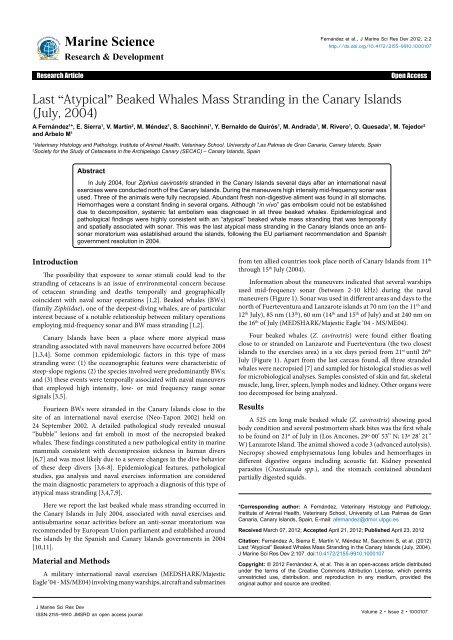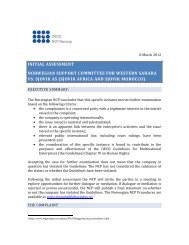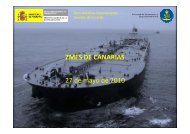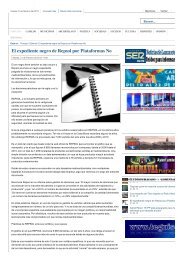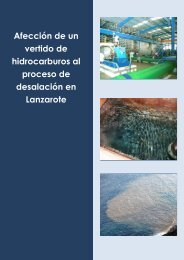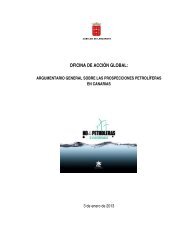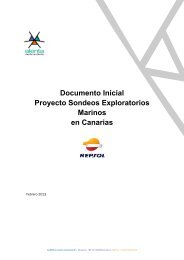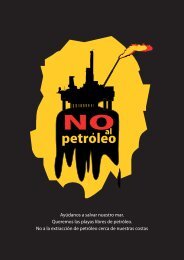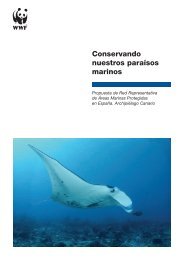Last “Atypical” Beaked Whales Mass Stranding in ... - No 0il Canarias
Last “Atypical” Beaked Whales Mass Stranding in ... - No 0il Canarias
Last “Atypical” Beaked Whales Mass Stranding in ... - No 0il Canarias
Create successful ePaper yourself
Turn your PDF publications into a flip-book with our unique Google optimized e-Paper software.
Citation: Fernández A, Sierra E, Martín V, Méndez M, Sacch<strong>in</strong>ni S, et al. (2012) <strong>Last</strong> <strong>“Atypical”</strong> <strong>Beaked</strong> <strong>Whales</strong> <strong>Mass</strong> <strong>Strand<strong>in</strong>g</strong> <strong>in</strong> the Canary Islands<br />
(July, 2004). J Mar<strong>in</strong>e Sci Res Dev 2:107. doi:10.4172/2155-9910.1000107<br />
Lanzrote<br />
Fuerteventura<br />
Canarv<br />
Islands<br />
On the 23 rd of July, a 500 cm long female beaked whale was found<br />
float<strong>in</strong>g near shore <strong>in</strong> Fuerteventura Island (Nuevo Horizonte, 28º<br />
24’ 48’’ N; 13º 50’ 53’’ W). The cetacean presented a good nutritive<br />
condition <strong>in</strong> an advanced autolytic status (code 4). The animal<br />
presented no caudal f<strong>in</strong> with several shark bites <strong>in</strong> the abdom<strong>in</strong>al area<br />
as well as <strong>in</strong> the melon. Dur<strong>in</strong>g necropsy, abundant fresh undigested<br />
food (cephalopods and crustaceans) was present with<strong>in</strong> the stomach<br />
compartments. Numerous parasites (Crassicauda spp.) were identified<br />
<strong>in</strong> the kidneys, and multiple calcified and fibrotic nodules were<br />
identified <strong>in</strong> the mesenteric arteries. The liver was very flaccid with<br />
enlarged venous vessels. Lung lobules were very emphysematous with<br />
gas-filled bullae, very likely due to postmortem autolysis. Hemorrhages<br />
were observed <strong>in</strong> the mandibular acoustic fat.<br />
On the 24 th of July, a 575 long male Z. cavirostris was found stranded<br />
<strong>in</strong> Fuerteventura Island (Majanicho, 28º 44’ 21’’ N; 13º 56’ 06’’ W) a few<br />
kilometers away from the previous strand<strong>in</strong>g. Nutritive condition was<br />
similar to first beaked whale, and the carcass also showed severe shark<br />
bites especially <strong>in</strong> the abdom<strong>in</strong>al cavity and head. Dur<strong>in</strong>g necropsy, this<br />
whale showed similar gross observations as <strong>in</strong> the previous described<br />
whale, <strong>in</strong>clud<strong>in</strong>g a large quantity of undigested fresh food <strong>in</strong> the<br />
stomach. Part of the digestive and reproductive tract was not present<br />
due to shark predation at sea.<br />
F<strong>in</strong>ally, four days later, on the 26 th an extremely putrefactive beaked<br />
whale of undeterm<strong>in</strong>ed sex was found beached <strong>in</strong> Fuerteventura Island<br />
(Puerto Lajas, 28º 32’ 25’’ N; 13º 49’ 75’’ W). The carcass was considered<br />
J Mar<strong>in</strong>e Sci Res Dev<br />
ISSN:2155-9910 JMSRD an open access journal<br />
Maiestic Eagle “04”<br />
operat<strong>in</strong>g area<br />
AFRICA<br />
Figure 1: (a) Naval exercises operat<strong>in</strong>g area. On the left side, Fuerteventura<br />
and Lanzarote islands with the locations where each beaked whale stranded.<br />
(b) A beaked whale float<strong>in</strong>g near shore and a diver approach<strong>in</strong>g the animal to<br />
fix it <strong>in</strong> order to br<strong>in</strong>g it to the coast. (c) A histological picture of a thoracic lymph<br />
node show<strong>in</strong>g numerous gas bubble together abundant fat globules of different<br />
size (Osmium post-fixation technique x 200). (Anti-Clock wise).<br />
Page 2 of 3<br />
code 5 (advanced decomposition) and therefore too autolysed for<br />
necropsy.<br />
Histologically, no <strong>in</strong>flammatory or neoplastic disease potentially<br />
responsible for the cause of death was detected <strong>in</strong> any organs from the<br />
three <strong>in</strong>vestigated beaked whales. Emphysematous areas <strong>in</strong> the lung<br />
parenchyma as well as with<strong>in</strong> the lymph nodes were demonstrated<br />
histologically. Gas bubbles were microscopically detected with<strong>in</strong> many<br />
vessels or tissues, but it was not possible to determ<strong>in</strong>e if these were<br />
due to putrefaction or some other process. However, us<strong>in</strong>g osmium<br />
post fixation technique, fat emboli were detected <strong>in</strong>travascularly <strong>in</strong> the<br />
lungs, kidneys, liver s<strong>in</strong>usoids and with<strong>in</strong> the lymph nodes <strong>in</strong> all three<br />
stranded whales.<br />
<strong>No</strong> herpes virus or Morbillivirus were detected molecularly by<br />
PCR. Isolated enterobacteria from these carcasses were not considered<br />
as bacterial postmortem proliferation and no pathogenic ones.<br />
Discussion<br />
Based on the strand<strong>in</strong>g data, this event was def<strong>in</strong>ed as an “atypical”<br />
beaked whale mass strand<strong>in</strong>g [2], <strong>in</strong>volv<strong>in</strong>g Z. cavirostris, the most<br />
common whale species associated with this k<strong>in</strong>d of strand<strong>in</strong>g. As before<br />
it was also temporally and spatially associated with naval activities<br />
us<strong>in</strong>g high <strong>in</strong>tensity mid-frequency sonar [3,4].<br />
It was suggested that, based on the sea currents dur<strong>in</strong>g and after<br />
the naval exercises, a carcass of that weight would be driven south from<br />
the area of the naval exercise to the northern part of the Canary Islands<br />
(Lanzarote and Fuerteventura), where these four carcasses eventually<br />
beached. This would suggest that beaked whales were orig<strong>in</strong>ally quite<br />
close to the area where naval exercises took place when alive. It would<br />
also suggest that the otherwise healthy BWs died relatively quickly at<br />
sea before strand<strong>in</strong>g dead on the beach or found float<strong>in</strong>g <strong>in</strong> seawater.<br />
This <strong>in</strong>dicates that beaked whale mass mortalities l<strong>in</strong>ked to naval sonars<br />
may have directly lethal effects without the need for strand<strong>in</strong>g alive on<br />
the beach [5].<br />
These three cases also support the observation (Fernandez, personal<br />
communication) that Z. cavirostris as a species always appear to float<br />
when the body is dead <strong>in</strong> the water, <strong>in</strong> contrast to other species from<br />
the same Ziphiidae family, like M. densirostris or M. bidens which may<br />
s<strong>in</strong>k after death. This observation suggests that other some acousticallyimpacted<br />
BW species may die at sea and subsequently s<strong>in</strong>k, so the real<br />
impact of sonar on this family may be under-represented by strand<strong>in</strong>g.<br />
From the pathological po<strong>in</strong>t of view, the high amount of “gas<br />
bubble” found <strong>in</strong> the three necropsied whales could not be considered<br />
as an evidence of “gas embolism” s<strong>in</strong>ce all three animals showed an<br />
advanced postmortem autolysis and no gas analysis methodology was<br />
then available as it is now [9]. However, the evidence of fat emboli <strong>in</strong><br />
these beaked whales together with the fact that all three died at sea, are<br />
highly suggestive that fat emboli was not due to trauma dur<strong>in</strong>g strand<strong>in</strong>g<br />
but was triggered and developed at sea and probably contribut<strong>in</strong>g to<br />
the whales relatively rapid death. This also shows that fat embolism is<br />
an important pathological f<strong>in</strong>d<strong>in</strong>g that can still be <strong>in</strong>vestigated even <strong>in</strong><br />
moderate to advanced autolytic stranded cetaceans [7,12].<br />
The results from mortalities occurred <strong>in</strong> 2002 and before [3,7]<br />
and the results present here provide scientific support for a nonb<strong>in</strong>d<strong>in</strong>g<br />
EU parliament resolution <strong>in</strong> 2004 ([http://www.nrdc.org/<br />
media/pressreleases/050210b.asp] and [http://www.nrdc.org /media/<br />
docs/050210a.pdf]) on the deployment of high <strong>in</strong>tensity sonars until a<br />
global assessment of its cumulative environmental impacts on whales,<br />
dolph<strong>in</strong>s, fish and other mar<strong>in</strong>e life is completed [10].<br />
Volume 2 • Issue 2 • 1000107
Citation: Fernández A, Sierra E, Martín V, Méndez M, Sacch<strong>in</strong>ni S, et al. (2012) <strong>Last</strong> <strong>“Atypical”</strong> <strong>Beaked</strong> <strong>Whales</strong> <strong>Mass</strong> <strong>Strand<strong>in</strong>g</strong> <strong>in</strong> the Canary Islands<br />
(July, 2004). J Mar<strong>in</strong>e Sci Res Dev 2:107. doi:10.4172/2155-9910.1000107<br />
Follow<strong>in</strong>g this resolution the Spanish parliament decided to<br />
establish a sonar moratorium around the Canary Islands [11] as a<br />
preventive measure to avoid these whales to be affected dur<strong>in</strong>g naval<br />
exercises, ma<strong>in</strong>ly <strong>in</strong> Fuerteventura coasts (Canary Islands). After<br />
seven years of this moratorium (2004), we can now present here the<br />
last beaked whale mass strand<strong>in</strong>g l<strong>in</strong>ked to naval exercises with sonar<br />
activities <strong>in</strong> the Canary Islands occurred <strong>in</strong> July 2004. <strong>No</strong> military sonar<br />
activities has been deployed s<strong>in</strong>ce then and no new atypical beaked<br />
whales mass strand<strong>in</strong>g has occurred <strong>in</strong> the Canary Islands from 2004<br />
until 2011. This undoubtedly represents the best supportive evidence<br />
for the EU parliament resolution [10] and Spanish moratorium [11]<br />
<strong>in</strong> 2004 when the last mass strand<strong>in</strong>g occurred <strong>in</strong> the Canary Islands.<br />
Acknowledgment<br />
This work was supported by the Spanish M<strong>in</strong>istry of Science and Innovation<br />
with two research projects: (AGL 2005-07947), and (CGL 2009/12663), as well as<br />
the Government of Canary Islands, project, SolSub C200801000288. Cabildo de<br />
Fuerteventura (Antonio Gallardo) and Reserva de la Biosfera de Fuerteventura.<br />
References<br />
1. Simmonds MP, Lopezjurado LF (1991) <strong>Whales</strong> and the military. Nature 351:<br />
448.<br />
2. Frantzis A (1998) Does acoustic test<strong>in</strong>g strand whales? Nature 392: 29.<br />
3. Cox TM, Ragen TJ, Read AJ, Vose E, Baird RW, et al. (2006) Understand<strong>in</strong>g<br />
J Mar<strong>in</strong>e Sci Res Dev<br />
ISSN:2155-9910 JMSRD an open access journal<br />
Page 3 of 3<br />
the impacts of anthropogenic sound on beaked whales. J Cetacean Res<br />
Manage 7: 117-187.<br />
4. Amico AD, Gis<strong>in</strong>er RC, Ketten DR, Hammock JA, Johnson C, et al. (2009)<br />
<strong>Beaked</strong> whale strand<strong>in</strong>gs and naval exercises. Aquatic Mammals 35: 452-472.<br />
5. Evans DL, England GR (2001) Jo<strong>in</strong>t Interim Report: Bahamas Mar<strong>in</strong>e Mammal<br />
<strong>Strand<strong>in</strong>g</strong> Event of 15-16 March 2000. US Department of Commerce and US<br />
Navy: Wash<strong>in</strong>gton DC.<br />
6. Jepson PD, Arbelo M, Deaville R, Patterson IA, Castro P, et al. (2003) Gasbubble<br />
lesions <strong>in</strong> stranded cetaceans. Nature 425: 575-576.<br />
7. Fernández A, Edwards JF, Rodríguez F, Esp<strong>in</strong>osa de los Monteros A, Herráez<br />
P, et al. (2005) “Gas and fat embolic syndrome” <strong>in</strong>volv<strong>in</strong>g a mass strand<strong>in</strong>g of<br />
beaked whales (family Ziphiidae) exposed to anthropogenic sonar signals. Vet<br />
Pathol 42: 446-457.<br />
8. Tyack PL, Zimmer WM, Moretti D, Southall BL, Claridge DE, et al. (2011)<br />
<strong>Beaked</strong> whales respond to simulated and actual navy sonar. PLoS One 6:<br />
e17009.<br />
9. de Quirós YB, González-Díaz O, Saavedra P, Arbelo M, Sierra E, et al. (2011)<br />
Methodology for <strong>in</strong> situ gas sampl<strong>in</strong>g, transport and laboratory analysis of<br />
gases from stranded cetaceans. Sci Rep 1: 193.<br />
10. European-Parliament (2004) European Parliament resolution on the<br />
environment effects of high-<strong>in</strong>tensity naval sonars.<br />
11. Daily sessions of the Congress of Deputies. Cdl Deputies, Editor 2004. File<br />
Number 180/000 345.<br />
12. Jepson PD, Deaville R, Patterson IA, Pocknell AM, Ross HM, et al. (2005)<br />
Acute and chronic gas bubble lesions <strong>in</strong> cetaceans stranded <strong>in</strong> the United<br />
K<strong>in</strong>gdom. Vet Pathol 42: 291-305.<br />
Submit your next manuscript and get advantages of OMICS<br />
Group submissions<br />
Unique features:<br />
• User friendly/feasible website-translation of your paper to 50 world’s lead<strong>in</strong>g languages<br />
• Audio Version of published paper<br />
• Digital articles to share and explore<br />
Special features:<br />
• 200 Open Access Journals<br />
• 15,000 editorial team<br />
• 21 days rapid review process<br />
• Quality and quick editorial, review and publication process<strong>in</strong>g<br />
• Index<strong>in</strong>g at PubMed (partial), Scopus, DOAJ, EBSCO, Index Copernicus and Google Scholar etc<br />
• Shar<strong>in</strong>g Option: Social Network<strong>in</strong>g Enabled<br />
• Authors, Reviewers and Editors rewarded with onl<strong>in</strong>e Scientific Credits<br />
• Better discount for your subsequent articles<br />
Submit your manuscript at: www.editorialmanager.com/environsci<br />
Volume 2 • Issue 2 • 1000107


